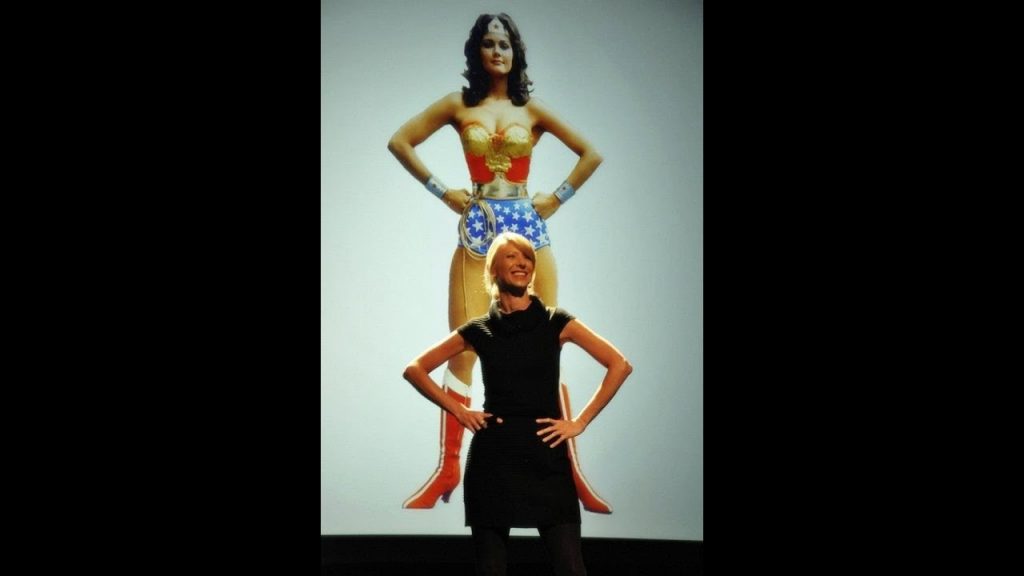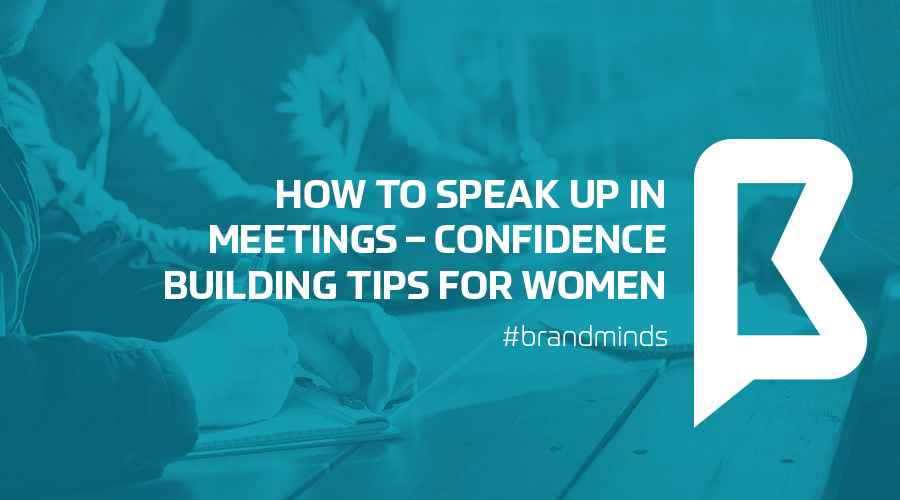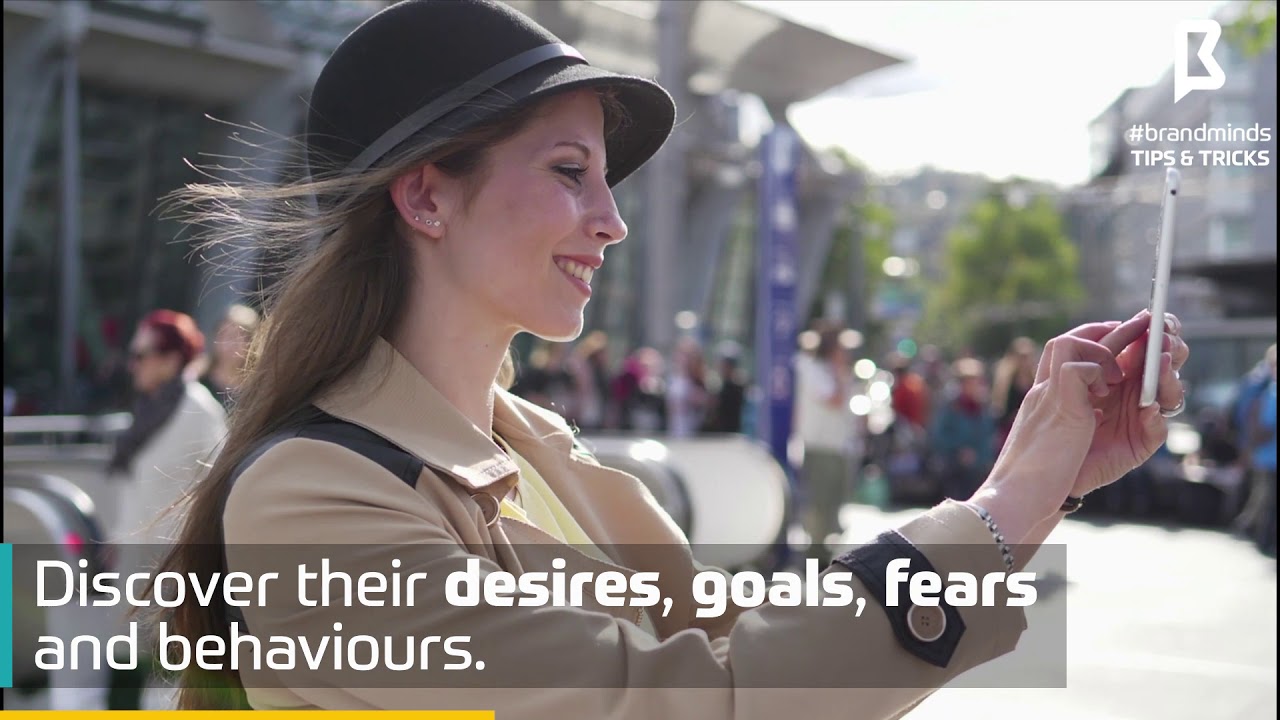Body language for women in business – 9 ways to look more confident
Whether you know it or not your body speaks about you without you having to open your mouth. It’s called body language or nonverbal behaviour and it can communicate a lot about your present state of mind or your level of self-confidence.
Just like we control what we say, we can control what our body says about us. It’s even more important for women in business who struggle with workplace biases.
9 ways women can use body language to look more confident in business situations:
1.Stop making yourself smaller

Image source: thebusinesswomanmedia.com
When we are growing up, we are taught that good girls don’t raise their voices, speak only when spoken to, sit quietly in one place and don’t bother anyone. Girls are expected to be invisible and take as less space as possible.
That’s what most grown women do: they make themselves smaller. Arms hanging on the side of the body, shoulders slouching, legs crossed.
Of course, you can’t do manspreading – it looks bad and it’s in poor taste to imitate men because you risk becoming a caricature of yourself.
Instead, you can do as follows:
- Extend the space you take up with your posture and possessions
- Straighten your back when sitting down
- Find a comfortable space for your elbows if you are sitting in a meeting
- Spread your notes on the table
2. Don’t over-nod
Women are generally supportive. They encourage their children and their spouse, other family members and friends. They are masters of active listening and show their empathy by nodding their heads in approval. Sometimes they over-nod to show support.
Over-nodding may be appropriate in family situations, but it’s inadvisable in business situations. So observe your body language and refrain from over-nodding.
If you’re talking to business partners, be sure to nod only when you really agree with someone, not by default.
3. Stop fake smiling
You don’t see parents asking their sons to smile and be nice, but you definitely see parents teaching their daughters to learn fake smiling early on. Women are used to hiding their true feelings and smiling even if they don’t feel like it.
In a business environment, your worth is not related to how much other people like you. You’ve been hired for your skills, creativity and work ethic. You are expected to deliver results and solutions, not being nice to everyone in the office.
You don’t go to the office to be nice and make friends.
You go to have an impact.

4. When nervous, refrain from self-comforting
When women are nervous, they tend to self-comfort by tucking their hair behind their ears, playing with a lock of hair, touching their face or adjusting their clothes.
These movements will be perceived as too feminine and they will take away from your professional power.
5. Give a firm handshake

Your appearance and looks generate the first impression while your handshake generates the second impression.
A firm handshake tells the other person that you are confident in your abilities and that you are well aware you deserve to be there.
You are as competent as your male counterpart so you need to convey this in your handshake. Your handshake should be firm, brief and accompanied by confident and steady eye contact.
6. Do the hand steeple

The woman is hand steepling
The hand steeple is when you prop up the fingers of one hand, with the finger of the other hand, to form a bridge. It’s a gesture of confidence and self-assuredness.
According to body language experts, “the steepler is someone that is confident, sometimes overconfident, genuine, authoritative, and particularly evaluative of others around him.”
Don’t use the hand steepling in team building because you could come off as arrogant. This gesture is effective if you already possess power or want others to think you do.

The woman standing has steepled fingers.
7. Keep head tilting to a minimum
The head tilt indicates sincere interest and curiosity.
Women and children tilt their heads to express admiration in a nonverbal way, to gain sympathy and protectiveness. It’s a posture which conveys vulnerability and submissiveness.
Try to keep the head tilting to a minimum so you don’t appear to lack authority or power.

The woman tilts her head while listening to the man.
8. Give an air of calmness and control
Women express themselves easily with words and gestures. They participate in conversations with a wide range of hand gestures, facial expressions, body position and movements. Among family and friends, women’s physical expressions are a way to connect and empathize.
In a business environment, an excessive amount of hand gesturing and body movement could be easily misinterpreted as a lack of control and people could have a hard time seeing you as a serious professional.
Give an air of calmness, control and allow people to take you seriously by keeping the amount of movement to a minimum.

9. Adopt the Wonder Woman pose
Wonder Woman is the symbol for a powerful woman. Remember her pose? Both feet standing firmly on the ground, chest out, straight back and hands resting confidently on the hips with the elbows flaring out.
The Wonder Woman pose is an expansive posture used to make the body appear larger and taking up more space. It’s the best posture to use before an important pitch to boost your confidence.

The Wonder Woman pose

Amy Cuddy doing the Wonder Woman pose / YouTube

Research has found that expansive postures such as this one help boost testosterone and simultaneously lowers the stress hormone cortisol.
Adopt this stance when you want to take on a leadership role and you want your team to perceive you as confident and ready to get down to business.
Discover high-power poses that you can adopt to feel more confident and powerful in this talk given by social psychologist Amy Cuddy:
Join the Conversation
We’d love to hear what you have to say.
Get in touch with us on Facebook Group and Twitter.
Source: bodylanguageproject.com
How To Market To Women Customers
As a marketer, your job is to find the best way to connect with your customers.
Are you marketing to women customers?
Find 4 recommendations in the video below:
Join the Conversation
We’d love to hear what you have to say.
Get in touch with us on Facebook Group and Twitter.
How to Speak Up in Meetings – Confidence Building Tips for women
Most women feel uncomfortable speaking up in office meetings.
This article points out the most common reasons why women keep silent at work, details the numerous abilities that women are born with and gives you 3 tips to help you begin speaking up in office meetings.

Angela’s Story
Angela is a twenty-something graphic designer just three months into her new job. She’s very quiet in meetings, thinking she’s new and she shouldn’t speak up. Dozens of comments, questions and ideas on various subjects run around in her head, but she refuses to speak them in meetings. She keeps silent because she doesn’t want to rock the boat.
Then a new guy joins the team. In the very first meeting, he voices the same questions and comments that she’s also thought of. He’s not holding back and he’s not afraid. The management is impressed by his ideas and critical thinking. They pat him on the back and tell everyone This is exactly why we hired you! Angela is frustrated and angry with herself: That should have been me! Why didn’t I speak up?!
Do you identify with Angela’s story?
If you do, keep reading.
Women hold themselves back
Talking to women who work in business environments we found they tell themselves any or all of the following:
- They assume their ideas are not new or worthy of being brought up;
- They don’t want to rock the boat and challenge the state of things;
- Are afraid of being perceived as aggressive;
- Assume they are not competent enough;
- Are afraid of looking foolish;
- They confuse critical thinking with being aggressive.
Women are simply better than they think they are
Ute Ehrhardt, the author of Good Girls Go to Heaven, Bad Girls go Everywhere says men are raised to be competitive. They learn to decide for themselves from early childhood even when they have very little information.
Inside the 348 pages of her book, Ute works hard to support her acknowledgement that women are just better than men. She backs up her belief with scientific arguments: studies and bodies of research, latest discoveries in neurobiology, questionnaires etc.
Here is a list of women’s innate abilities which Ute talks about in her book:
- High level of empathy;
- Better communication skills;
- Higher ability to negotiate;
- Increased sensory perception;
- Distributive attention;
- Higher ability to sustain physical stress;
- Leadership qualities that rely on collaboration, fairness, correct use of team members’ competences;
- Organisational skills;
- Women’s thinking patterns are based on a network-model instead of the linear-model thinking of men;
- Women find unexpected solutions to a problem by looking at it from different angles;
- Women’s brains are capable of assimilate and process increased amounts of data and information with little effort;
- Women’s intuition works faster and more reliable than their minds.
Women sabotage themselves because they lack self-confidence
The only reason women don’t speak up in meetings at work is because they are not as confident as their male colleagues.
As little girls, they have been raised to behave, speak politely and only talk when asked a question. As grown-ups, women help and support the others, wanting to please and assist them in reaching their goals or potential.
Ute says:
„the female urge to help is too strong. We don’t separate others’ wishes from our drive to satisfy them – although there is no connection between the two.”
[bctt tweet=”Discover 3 tips to build your confidence if you want to speak up in meetings” username=”brand_minds”]
How to build your confidence – 3 tips
You can build your self-confidence if you start acknowledging the natural abilities that nature has bestowed upon you and start using them to your benefit.
Do you want to build your confidence?
This is what you need to do.
- Acknowledge that you are the expert on your subject or niche, no one else knows more than you do;
- Always remember that your professional background and experience entitles you to speak up and be heard;
- Set up goals of speaking up for 1 minute at every meeting.
Here are three simple ways to help you speak up in meetings:
1. Start by asking questions
Asking questions invites discussion, it opens up the door for brainstorming and it is a way to present yourself as an analytical and logical person.
2. The Yes, ….plus/furthermore…..method
Start by acknowledging what the previous speaker said, then tell your idea like so:
Yes, it’s a great proposal, plus we can also do it this way…
Your idea is great, moreover here’s another approach I’m thinking of right now…
Yes, we can do it this way, furthermore we can also put it this way: ….
Notice the structure of the phrase: you give a positive feedback, followed by moreover/furthermore and your input. Maybe your colleagues won’t like or accept your suggestion, but you would have given it in a nonconflicting manner.
3. Follow your intuition, but back it up with data
Intuition is a very powerful quality. Don’t ignore it! Go with your intuition and ask for answers when something feels wrong or sounds fake. Be persistent and don’t give up unless you get to the bottom of things.
But you cannot present your intuition as your main argument for business suggestions or operations improvements unless it comes with a valid explanation as well. Imagine the looks on your colleagues’ faces if you say I just have a feeling it would be better this way… Check what your intuition tells you with facts and figures, reports, whitepapers etc.
Conclusion
Women are as competent as men. You have earned the right to speak up and be heard. What holds you back is no one but yourself.
Be self-aware of your accomplishments and experience. Remember that your perspective is unique and your input is original. Take steps towards building your confidence every day.
Campaigns That We Admire: The Humanity Test by JWT London
UN Women NC UK and J Walter Thompson London recreated the reCAPTCHA ‘human tests’ that are commonly used by websites against spam bots to raise awareness of the 39,000 girls forced into child marriages every day.
The Humanity Test requires users to prove their humanity by selecting pictures of brides, before revealing the child brides they overlooked and their stories. So far 72% of 8,806 people who have taken the test have failed it by not accurately identifying images of all brides.
The test then prompts participants to help #drawaline against child marriage – which affects 750,000 women and girls around the world, yet is rarely discussed as a major humanitarian problem. Participants can support the cause further by sharing the humanity test across social media, and thus spreading awareness about the issue, mobilizing support for the cause and UN Women NC UK’s mission. The creative sheds a light on the issue of child marriage by playing on people’s preconceptions of marriage as shaped by conventional cultural representations, challenging them to reconsider their assumptions and share the test as a result.

This project is a continuation of UN Women NC UK’s #drawaline campaign which launched in November last year with an initial focus on urging the public to draw a line to end violence against women and girls. The November launch was supported by celebrities including Billie Piper, Benedict Cumberbatch, Deliciously Ella, Gemma Styles and ITV’s Alastair Stewart. As the next phase of the #drawaline campaign, the Humanity Test aims to generate the same awareness and conversation around the equally important issue of child marriage.
Lucas Peon, executive creative director at J. Walter Thompson London, noted, “We needed to tell these stories and bring attention to this shocking issue in a way that couldn’t be ignored. The Humanity Test hits people when they least expect it, holding up a mirror to their preconceptions and sanitized view of the world.”
Steve Edwards, chief marketing officer of UN Women National Committee UK, added:
In an environment where charity organisations clamor for a share of the population’s compassion, we asked JWT to find a way to elevate our message in peoples’ hearts and minds. JWT has used insights into human behavior to create this unique idea with unsettling results. We hope that the sheer numbers of people who failed the test will shed light on the gulf between our everyday reality and the issues facing millions of real women and girls elsewhere in the world. One of the biggest challenges for a cause is to help audiences relate to the human at the end of a charity’s aid programme. By challenging perceptions around a key issue facing women, JWT are encouraging audiences to engage with UN Women NC UK, take action to support us, and be the catalyst for global change.”
Creative agency: J. Walter Thompson London
Executive Creative Director: Lucas Peon
Creatives: James Hobbs & Jeremy Little
Creative Producers: Laurie Carter & Joseph Bassary
Creative Technologists: Dave Morgan & Vicky Keeley
Planner: Eleanor Metcalf
Senior Account Director: Mini Sinha
Account Managers: James Llewelyn-Davies & Karen Barak
Designer: Lee Jarrold
Client: UN Women NC UK
Chief Marketing Officer: Steve Edward
Why we like it:
- responds to a real social problem in a creative way
- attracts attention to the real situation
- great and full of impact idea
- innovative manner of approaching it
- started the right conversations on the topic
5 Things you might not know about Madonna Badger
Chief Creative Officer & Founder of the Badger & Winters, Madonna Badger describes it as an advertising, branding and design agency specializing in creating powerful ideas that establish enduring emotional connections with women. Being creatively led by a woman, it informs their collaborative process and deeply empathic approach to understanding women’s values and desires.
“Our goal is nothing short of brand love,” says Madonna Badger on Linkedin.
Interested in knowing more about one of Brandminds’ 2017th Asian Summit speaker? Here are some fact you might not know about her:
1.She is credited with creating the famous Calvin Klein ad featuring Mark Wahlberg.
2. She was featured on the Crain’s New York Business 40 Under 40 list in 1996.
3. In a campaign with the hashtag #WomenNotObjects, the Manhattan advertising executive is looking to fight the objectification of women in the marketing and advertising world. “People are really seeing that objectifying women is really up there with inequality of women,” Badger told Matt Lauer on TODAY Tuesday. “I think that sex sells, but you know what the worst part is? It’s the harm we’re doing, and for me, that’s really what made me make this decision.” Badger has also pledged that her firm, Badger and Winters Group, will not use women as props or overly re-touch photos of women in their advertising.
4. “#WomenNotObjects” has helped Badger & Winters reshape itself as an agency and focus on assisting clients across all industry categories to connect with women in genuine ways, said Mr. Winters, for AdAge.com.
5. In June, for the 2017 Cannes Festival of Creativity, Ms. Badger spoke on a panel about gender, diversity and objectification of women with Procter & Gamble Chief Brand Officer Marc Pritchard.
To multitask or not? This is the question
When I was little, my parents taught me to do one thing at a time and do it the best possible. Not trying to start ten projects or jump from one thing to another without finishing what I began first. Although I’ve always had the internal push to do several things at one time, I kept remembering their advice and trying to stick to it. As much as possible. Back then, the idea of multitasking wasn’t around and known to us, but I believe they were right. And recent studies seem to back them up as well.
According to Larry Kim, Founder and CTO WordStream, our brains are designed to focus on one thing at a time, and bombarding them with information only slows them down. MIT neuroscientist Earl Miller notes that our brains are “not wired to multitask well… when people think they’re multitasking, they’re actually just switching from one task to another very rapidly. And every time they do, there’s a cognitive cost.”
This constant task-switching encourages bad brain habits. When we complete a tiny task (sending an email, answering a text message, posting a tweet), we are hit with a dollop of dopamine, our reward hormone. “Our brains love that dopamine, and so we’re encouraged to keep switching between small mini-tasks that give us instant gratification. This creates a dangerous feedback loop that makes us feel like we’re accomplishing a ton, when we’re really not doing much at all (or at least nothing requiring much critical thinking). In fact, some even refer to email/Twitter/Facebook-checking as a neural addiction,” said Larry Kim for inc.com.
As shown by Marketing Week, Academics at Vanderbilt University found evidence in 2006 that the brain’s frontal lobe creates a “bottleneck of information processing that severely limits our ability to multitask”. The proliferation of media channels and devices makes this worse. Another study, published by Stanford University researchers in 2009, found “heavy media multitaskers are more susceptible to interference from irrelevant environmental stimuli and from irrelevant representations in memory”. And this hampers the ability to switch between tasks.
We can shift our focus really fast, sometimes it takes just a 10th of a second. But the time doesn’t matter as much as the bandwidth the brain requires to move back and forth. Now that might affect your performance, and might also affect the quality of the work that you finally produce.
New research suggests the possibility that cognitive damage associated with multi-tasking could be permanent.
A study from the University of Sussex (UK) ran MRI scans on the brains of individuals who spent time on multiple devices at once (texting while watching TV, for example). The MRI scans showed that subjects who multitasked more often had less brain density in the anterior cingulate cortex, the area responsible for empathy and emotional control. Unfortunately, the research isn’t detailed enough to determine if multitasking is responsible for these affects, or if existing brain damage results in multitasking habits.
Moreover, there have been studies that show women are generally better at multitasking than men. Also, people who thought they were the best at multitasking are almost always in fact the worst. In fact, multitasking seems to be something not all of us are truly able to achieve, as only about 2% of the population is formed of super multitaskers (people who are truly able to do several different activities at the same time without losing efficiency or losing quality as they do all that work). Most of us don’t have this gift.
According to Forbes, the problem with trying to multi-task is all that shifting back and forth between tasks isn’t all that efficient because, each time we do it, it takes our brain some time to refocus. So while it might seem efficient on the surface, it isn’t – studies show that multi-tasking can reduce productivity by as much as 40%.
More than that, a study published by the American Psychological Association concluded that the ability to switch between tasks, which they term, “mental flexibility” generally peaks in the 20s and then decreases with age, in average of 30.9% from a person in their 40s to a person in their 70s. The extent to which it decreases depends upon the type of tasks being performed. The information is back up by another study, this time around conducted on UK soil, at the University of London where the results have shown that the participants who multitasked during cognitive tasks, experienced an IQ score decline similar to those who have stayed up all night. Some of the multitasking men had their IQ drop 15 points, leaving them with the average IQ of an 8-year-old child.

